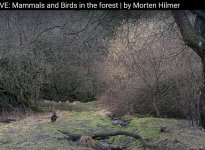-
Welcome to BirdForum, the internet's largest birding community with thousands of members from all over the world. The forums are dedicated to wild birds, birding, binoculars and equipment and all that goes with it.
Please register for an account to take part in the discussions in the forum, post your pictures in the gallery and more.
You are using an out of date browser. It may not display this or other websites correctly.
You should upgrade or use an alternative browser.
You should upgrade or use an alternative browser.
Danish Woodland Webcam (4 Viewers)
- Thread starter RecoveringScot
- Start date
More options
Who Replied?Farnboro John
Well-known member
You're spending too much time watching this....Birds alarming a lot at 11:28 - a new mammal walked through ...
On another note, keeping an eye on the catkins developing in the centre of the image.
John
dantheman
Bah humbug
Badger at 00.53
Looked from 00:52 to 00:54 - but didn't see one. Are you going on the time stamp in the bottom left corner of the video?
dantheman
Bah humbug
It's the small white numbers in the far left hand corner of the image - eg behind the 'play' icon in RSs images on post #20.It was right at the start of the red bar - I’m not very tec savvie! I couldn’t see the toad either so we’re at cross purposes some how!
Just saw the yellowhammer - right hand side behind the grassy knoll
The red bar can be anywhere, depending on whether you are watching live or not, and Denmark is also an hour ahead of eg the UK. The physical time stamp on the video itself is the only sure fire way of anyone in the world knowing they are looking at the same time afaiw.
dantheman
Bah humbug
I looked at the spreadsheet I linked on the thread a week or two back - turns out there are loads of different foxes visiting, all named. Crazy. I guess the mammal watching enthusiasts are pretty dedicated, although I guess some are seen in the daytime when individual features to distinguish them more easily seen? Was also slightly amused that the two male pheasants had both been named Steve! (if I had that right).Assumed the foxes were a pair, but there are now 3 - siblings.?
Last edited:
Farnboro John
Well-known member
Foxes are fairly easy to identify as individuals if you watch them closely. I use a combination of size, sex, "boots" (black leg markings, extent and any patterning), white brush tip presence/absence and extent, face markings and in cases of real difficulty I go to front of ear marginal markings. Temporarily (because they change rapidly) I also use bites and other injury marks.I looked at the spreadsheet I linked on the thread a week or two back - turns out there are loads of different foxes visiting, all named. Crazy. I guess the mammal watching enthusiasts are pretty dedicated, although I guess some are seen in the daytime when individual features to distinguish them more easily seen? Was also slightly amused that the two male pheasants had both been named Steve! (if I had that right).
Names are a good shorthand: nobody wants to write out "the huge dog fox with the big white brush tip, long black boots and a permanent right cheek scar" all the time so Scarface might be a name to use instead. If you are feeding a group then they can learn their names as well: if you are going to use names pick different-sounding ones to make it easier for them.
You're right. I'm crazy.
John
RecoveringScot
Well-known member
Farnboro John
Well-known member
Star I should think.20.36 something shiny appears in the very right hand top of the tree - can anyone work out what it is?
Looks like eye shine, but it only one and larger, but at very edge of picture!
John

Tawny owls contact calling  followed by some foxes - possibly squabbling or something else……
followed by some foxes - possibly squabbling or something else……
….. two of my Year 7 students bought me the top half of what I think is a foxes skull they found on the school grounds this week. I have ordered a plastic one from Amazon to show them what a full one looks like and to check identity.
….. two of my Year 7 students bought me the top half of what I think is a foxes skull they found on the school grounds this week. I have ordered a plastic one from Amazon to show them what a full one looks like and to check identity.
Last edited:
Similar threads
- Replies
- 3
- Views
- 391
Users who are viewing this thread
Total: 5 (members: 0, guests: 5)




